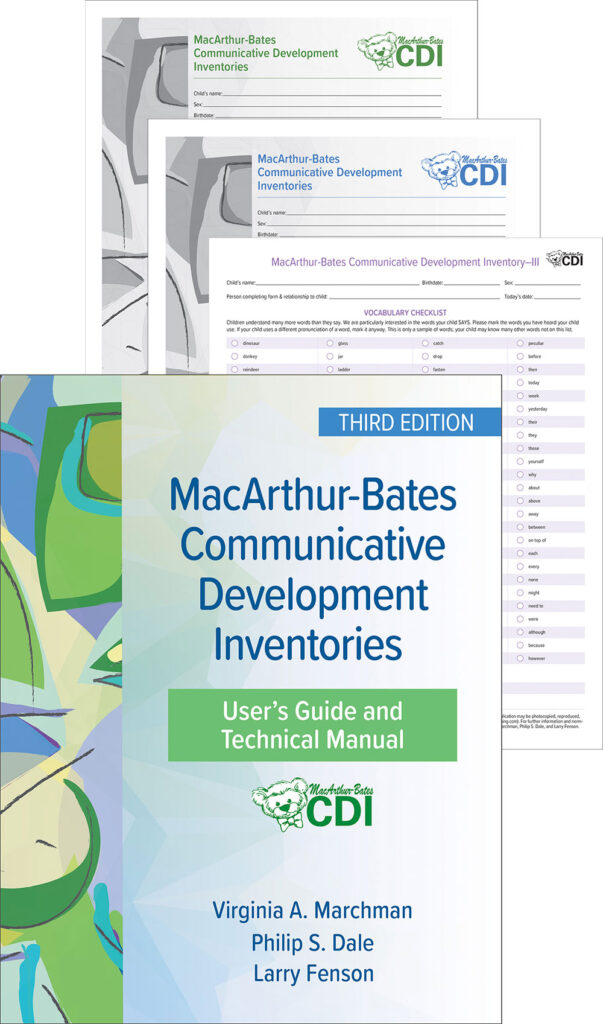Tool Spotlight: NEW Edition of the MacArthur-Bates Communicative Development Inventories
April 20, 2023
 Good news for early childhood professionals: the third edition of the MacArthur-Bates Communicative Development Inventories (CDIs) are now available. Capture parents’ knowledge of their child’s emerging language and communication skills with the new edition of these widely used measures, developed by top language researchers Virginia A. Marchman, Philip S. Dale, and Larry Fenson in collaboration with the CDI Advisory Board. Learn about the CDIs and what’s new to the third edition in today’s spotlight post!
Good news for early childhood professionals: the third edition of the MacArthur-Bates Communicative Development Inventories (CDIs) are now available. Capture parents’ knowledge of their child’s emerging language and communication skills with the new edition of these widely used measures, developed by top language researchers Virginia A. Marchman, Philip S. Dale, and Larry Fenson in collaboration with the CDI Advisory Board. Learn about the CDIs and what’s new to the third edition in today’s spotlight post!
What are the CDIs?
The MacArthur-Bates Communicative Development Inventories (CDIs) are one of the most popular and recommended measures of language and communication for young children. The CDIs yield valid, reliable information on the course of language development, from children’s early signs of comprehension to their first nonverbal gestures, their first words, and the beginnings of grammar.
Used in both research and clinical settings by a variety of professionals—psychologists, pediatricians, speech-language pathologists, early interventionists, and education researchers—these parent report instruments help practitioners:
- screen children
- develop a prognosis for children with language delays
- plan effective intervention
- monitor progress
- meet mandates for including parent input in child evaluation
What ages are the CDIs for, and what do they measure?
The CDIs are for children ages 8–37 months, though they may be used with older children with developmental delays. There are separate measures for three age ranges:
-

Words and Gestures form (ages 8 to 18 months). With this instrument, parents document the child’s understanding of hundreds of early vocabulary items, and the form yields separate indexes of words understood and words produced. Then, parents record communicative and symbolic gestures the child has tried or completed.
- Words and Sentences form (ages 16 to 30 months). Parents use this instrument to document the child’s production of hundreds of words, record the child’s use of early forms of grammar, and provide written examples of the child’s three longest utterances.
- CDI-III (ages 30 to 37 months). This shorter, single-sheet tool measures expressive vocabulary and grammar.
Why are parent report instruments like the CDIs an effective way to evaluate child language?
As the CDI developers outline in the User’s Guide and Technical Manual, parent report has a number of advantages over other means of assessing child language:
- Because the parent has the opportunity to observe the child in a wide range of situations, parent report can provide data that are more representative of the breadth of the child’s actual language than would be observed in a laboratory sample or a structured test.
- A child’s performance in a laboratory or clinic setting may be strongly influenced by aspects of the child’s personality such as shyness and by transient factors such as mood. Parent report should be less susceptible to such factors.
- Parent report is a cost-effective means for a rapid general evaluation of language. This can be valuable for screening purposes in clinical and educational settings as well as research applications.
- Parent report can be obtained in advance of actually seeing a child and can help in selecting assessment procedures for more in-depth analyses.
- Clinicians can use parent report as an adjunct to check the validity of their own evaluations, which would be based on a more limited interaction with the child.
- Because parent report is based on behavior in contexts outside the clinic or laboratory, it’s especially valuable in monitoring changes in language over time, including monitoring the progress of intervention.
What’s new in this edition of the CDIs?
The third edition of the CDIs includes updated norms, additional tools, and more administration formats and helpful resources. Here’s a look at what’s new:
- Expanded and more representative norms—more than 4,000 new children have been added to the norming dataset for the CDI: Words and Gestures and CDI: Words and Sentences. Norming tables have been statistically adjusted to reflect key U.S. demographic indicators.
-

More options for electronic administration of the CDIs, including fillable PDFs and a new web-based administration platform, Web-CDI
- New picture-based instructions with easy-to-understand illustrations and examples
- More extensive administration and scoring guidelines
- More on using the CDIs with bilingual and multilingual children
- An expanded chapter on the CDI-III
- Detailed guidelines about choosing the most appropriate CDI forms when several are potentially useful
- Expanded guidelines on the use of CDI short forms, including new statistically-adjusted norms and information on reliability and validity
- More CDI resources available online, including Wordbank, an open repository of CDI data in 38 languages representing more than 84,000 children
- A rapid, valid Computerized Adaptive scale for expressive vocabulary, now available through Web-CDI
- A helpful list of frequently asked questions
The CDIs are a must for SLPs and other professionals charged with screening children, planning interventions, and monitoring progress. Add the third edition to your toolbox today!






Write a Comment
Your email address will not be published. Required fields are marked *
Post a Comment